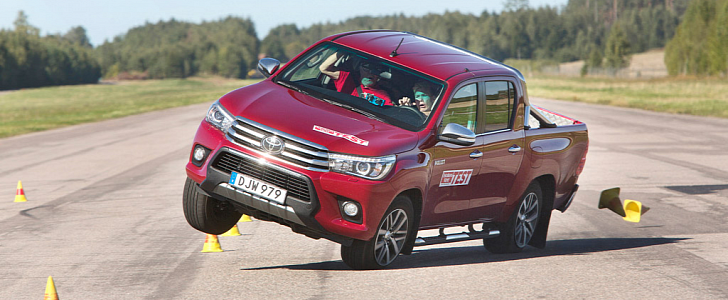Toyota will modify the Hilux pickup truck to improve its stability after failing the moose test in an independent examination done by a Swedish magazine.
For those of you who do not recall, Teknikens Värld published a video and a report last September of its moose test that featured a Toyota Hilux. The Japanese pickup truck failed the test at 37 mph (60 km/h) while being fitted with 18-inch wheels. Its predecessor failed the same test in 2007, with 16-inch alloys, which were removed from the offer until the situation was corrected.
In the case of the 2017 Hilux, Toyota decided to redo the test with its specialists, and find out where they can improve. After almost four months of trial and error, the Japanese brand has notified the Swedish magazine that it has developed a package of measures to prevent the dangerous behavior from happening in real life.
The Japanese company has tested the Hilux in both ISO-standard avoidance maneuver and in the particular procedure employed by the Swedish magazine, which is slightly different.
Evidently, both tests focus on avoiding an obstacle at a distinct speed, and they are done by taking a sharp left turn, followed by a sharp right. The second one is the trickiest for the models that may be deemed unstable.
Toyota’s proposed safety package involves two stages - changing the tire pressure for the maximum load, and the modification of the electronic stability control’ operating procedure. The latter will be focused on reducing the speed of the vehicle in the event of an evasive maneuver, which should reduce or eliminate this risk.
Toyota has shown the Swedish publication videos of its tests, with before and after clips, which journalists have said that the measures seem to be working. Toyota has invited Teknikens Värld to Spain, at the IDIADA testing facility, to try out the new configuration.
Most likely, the existing models could receive a precautionary safety recall, while the units that are being built will be shipped with the improvements already in effect.
This situation should make other automakers ensure that their vehicles pass these tests in all possible conditions within reason (above a certain speed, these evasive maneuvers are dangerous in many automobiles).
In the case of the 2017 Hilux, Toyota decided to redo the test with its specialists, and find out where they can improve. After almost four months of trial and error, the Japanese brand has notified the Swedish magazine that it has developed a package of measures to prevent the dangerous behavior from happening in real life.
The Japanese company has tested the Hilux in both ISO-standard avoidance maneuver and in the particular procedure employed by the Swedish magazine, which is slightly different.
Evidently, both tests focus on avoiding an obstacle at a distinct speed, and they are done by taking a sharp left turn, followed by a sharp right. The second one is the trickiest for the models that may be deemed unstable.
Toyota’s proposed safety package involves two stages - changing the tire pressure for the maximum load, and the modification of the electronic stability control’ operating procedure. The latter will be focused on reducing the speed of the vehicle in the event of an evasive maneuver, which should reduce or eliminate this risk.
Toyota has shown the Swedish publication videos of its tests, with before and after clips, which journalists have said that the measures seem to be working. Toyota has invited Teknikens Värld to Spain, at the IDIADA testing facility, to try out the new configuration.
Most likely, the existing models could receive a precautionary safety recall, while the units that are being built will be shipped with the improvements already in effect.
This situation should make other automakers ensure that their vehicles pass these tests in all possible conditions within reason (above a certain speed, these evasive maneuvers are dangerous in many automobiles).



